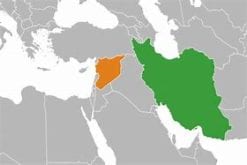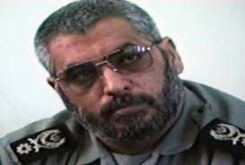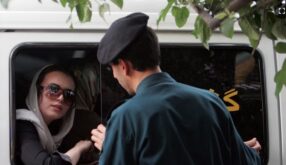 RFL/RE – The United States says Russia’s use of an Iranian air base to carry out air strikes in Syria is “unfortunate but not surprising.”
RFL/RE – The United States says Russia’s use of an Iranian air base to carry out air strikes in Syria is “unfortunate but not surprising.”

U.S. State Department spokesman Mark Toner said on August 16 that the use of Iran’s Hamadan air field would not definitively prevent Washington from cooperating with Moscow on resolving the humanitarian crisis in Aleppo or fighting against the Islamic State (IS) extremist group in Syria.
But he said U.S. officials were “not there yet” on a cooperation agreement with the Kremlin and cited Russia’s continued bombing of moderate Syrian forces that the United States and its allies support.
Earlier, Russian state media said that warplanes had flown air strikes in Syria from an Iranian air base, soon after officials in Moscow and Tehran announced the unprecedented cooperation as an effort to battle IS militants.
Russia’s Defense Ministry said the August 16 air strikes were carried out by Tupolev Tu-22M3 long-range bombers and Sukhoi Su-34 strike fighters that took off from the Hamadan air field in northwestern Iran.
There was no word on how many bombers were deployed.
U.S. military spokesman Chris Garver said Washington was informed ahead of time about the Russian bombing raid as required by a mutual agreement on flight safety and that it “did not impact coalition operations in either Iraq or Syria during the time.”
The Syrian Observatory for Human Rights (SOHR) said air raids on August 16 against two rebel-held districts in Syria’s second city of Aleppo killed at least 19 civilians.
SOHR head Rami Abdel Rahman said the strikes on Tariq al-Bab and Al-Sakhur, which reportedly killed three children, were either carried out by Russian or Syrian government aircraft and had also wounded dozens of people.
Rahman could not confirm that the air strikes were made by the Russian warplanes that had taken off from the Iranian air field.
The Russian military had previously launched such strikes only from its own soil or Syrian territory, where Moscow ally President Bashar al-Assad has been waging a five-year war to hold onto power in the face of an Islamist militant threat and Western backing for Assad’s political and armed opponents.
The Russian attacks appear to mark the first time Tehran’s staunchly anti-Western leadership has permitted a foreign country to use Iran to stage military operations since the 1979 Islamic Revolution.
Russian state channel RT reported that the development allows the Russian air force to drastically reduce flying times to targets in Syria, where Moscow has been waging a bombardment campaign since September with the publicly stated aims of propping up Assad and fighting Islamist militants.
Widening Russia’s Footprint
Russia has long leased a naval facility in the eastern Mediterranean port city of Tartus and last year built up forces at the Khmeimim air base near Latakia, in northwestern Syria.
In addition to widening Russia’s footprint in the region, Putin’s maneuvering over Syria is also widely perceived as an attempt to accrue influence on the international stage that might help eclipse Moscow’s isolation over its invasion of Ukraine in 2014.
Moscow has been working loosely for months with Tehran, which has provided Assad with ground troops and appears increasingly invested in the fate of the Syrian regime.
The United States, Turkey, and their allies have repeatedly called for Assad’s exit, and international talks to bring about a political solution in Syria remain stalled.
Moscow has insisted that talks with Washington are nearing an agreement to boost cooperation in Aleppo, a prewar industrial hub that has seen some of the worst fighting.
More than a quarter-million Syrians have been killed since the conflict began in 2011, and many millions more have been displaced internally or fled to Turkey or farther west.
The Russian Defense Ministry claimed the August 16 air strikes successfully hit IS facilities in three northern Syrian provinces, including arms depots and training camps.
The Reuters news agency reported that Russian state TV aired images of at least three Russian Tu-22M3 bombers and a military transport plane inside Iran.
Vladimir Komoyedov, chairman of the Russian Duma’s Defense Committee, said the use of the Iranian base would “save fuel and enlarge bomb loads.”
Closer Consultation
The head of Iran’s Supreme National Security Council appeared to confirm the reports, saying that Tehran and Moscow are sharing facilities to fight against “terrorism.”
“Iranian-Russian cooperation in the fight against terrorism in Syria is a strategic one, and we share our potential and facilities in this field,” Ali Shamkhani was quoted as saying in an interview with the Iranian government news agency IRNA.
On August 15, Putin’s top Middle East envoy, Mikhail Bogdanov, held talks in Tehran with Iranian Foreign Minister Mohammad Javad Zarif.
Iran’s English-language Press TV reported that the two sides stressed “the importance of closer consultation between Iran and Russia on ways to solve the crisis in Syria.”
In January, Moscow and Tehran signed a military cooperation deal focused on wider cooperation on training and fighting terrorism.
Also on August 16, the New York-based rights monitor Human Rights Watch (HRW) accused the joint Russian-Syria military operation in Syria of using incendiary weapons in civilian areas.
HRW said air-dropped incendiary weapons had been used at least 18 times in the past six weeks. It urged the countries of the Convention on Chemical Weapons to condemn the action when they meet in Geneva on August 29.
“These weapons inflict horrible injuries and excruciating pain, so all countries should condemn their use in civilian areas,” HRW arms director Steve Goose was quoted as saying.
IS controls swaths of Syria and neighboring Iraq, where it has employed ruthless tactics like summary executions and mass killings of captives in an effort to establish what it claims is a worldwide Islamic caliphate.
Putin announced the start of a withdrawal of the “main part” of Russian forces in March, suggesting the country had “achieved its aims.”
 Shabtabnews In this dark night, I have lost my way – Arise from a corner, oh you the star of guidance.
Shabtabnews In this dark night, I have lost my way – Arise from a corner, oh you the star of guidance.


